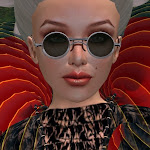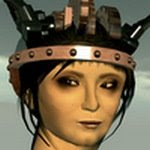I just had the pleasure of meeting a delightful 2D individual by the name of Dammit Dawg, as well as the creator of his avatar, Holly Loll. 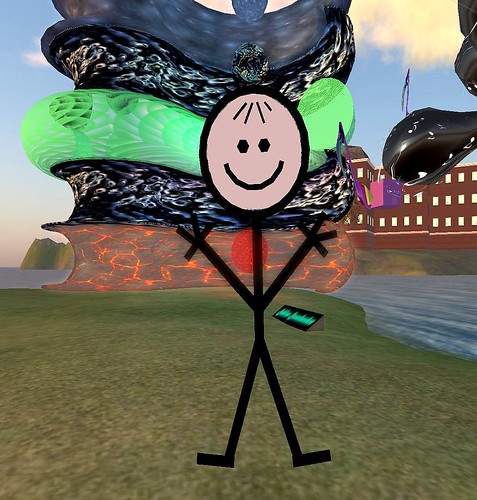
Sadly, Dammit shared with me that "Being born 2D in a 3D world is full of challenges. First, there is the discrimination and instant banning from certain sims to put up with. Second, there is the problem of getting used by 3D avatars as a coat rack or clothes hanger. Third, there is the lack of any 2D office furniture for the 2D man."
The good news is that Holly realized that she couldn't just create 2D peeps and not provide them with some kind of infrastructure, such as a 2D office line. Dammit admits that he was initially skeptical - especially when he saw the first thing she made for him (a paper shredder) - but everything worked out in the end.
You can visit Holly's 2D village for Dammit and others like him - and try out the paper shredder yourself - at a site where fellow hobo Dingle Doigts is sponsoring a build contest, by teleporting here. 
An Easter portrait of the Dammit family
Dammit also informed me that the 2D avatars are a Second Life homage to Matt Feazell who used to draw the mostly underground Cynical Man series. "I loved that cartoon in college (he used to draw them in a nice cafe across the street from where I did my homework at a much grungier and more dangerous cafe in Minneapolis), and would wait every week to read his stuff," said Dammit.
Sunday, March 30, 2008
Relief for the 2D man
Posted by
Bettina Tizzy
at
6:06 PM
0
comments
![]()
Labels: 2D, avatar, Dammit Dawg, Dingle Doigts, Holly Loll, Matt Feazell, Not Possible IRL, NPIRL, Second Life, stick figure, village
TRON fans treat
Via AngryBeth Shortbread, this killer remake of the Lightcycle scene from TRON by freres hueon; soundtrack taken from the film by writer/director Steven Lisberger)
"A world inside the computer where man has never been. Never before now."
Posted by
Bettina Tizzy
at
2:33 PM
0
comments
![]()
Labels: AngryBeth Shortbread, freres hueon, music video, remake, Steven Lisberger, TRON
CodeBastard Redgrave splashes the grid - and NPIRLers - with RED
We are avatars in our virtual world, yes... little dollies we dress up, when you get right down to it. But personalities are often more distinct and discernable - larger than life, really - in this format.
Such is the case of a passionate, charming, and funny woman who rezzed the same month I did, some 14 months ago. Add to this that she is 7'6" tall, wears bright red from her locks to her toes, and is sporting the name CodeBastard Redgrave... Well, you just know there isn't going to be a bland pixel about her. 
Turns out that her powers of persuasion are over the top, too. She's talked the knickers off of some of the most interesting ladies in Second Life... including a few of our own! In the tradition of the fabled Vargas pin-up girls, she stripped them down, splashed them with red, and then captured the moment for all eternity. 
Jurin Juran
Amalthea Blanc
Lainy Voom
Today at 11am SLT, she is unveiling Boudoir Rouge - a collection of those photographs - at her gallery: Code Red. Dress code? C'mon... Hazard a guess! Teleport directly from here.
Posted by
Bettina Tizzy
at
2:37 AM
3
comments
![]()
Labels: Amalthea Blanc, avatars, Boudoir Rouge, Code Red, CodeBastard Redgrave, Jurin Juran, Lainy Voom, NPIRLers, photography, Second Life, women
Friday, March 28, 2008
Starbase C3's new sim-wide Skybase Vigilance
all photography by Wellington Bahram
Cube Inada (aka Larry Rosenthal), has been creating and running 3D virtual worlds online since 1996, beginning with Starbase C3, the first real-time 3D world on AOL. Since 2006, Cube has integrated Starbase C3 and its active membership into Second Life with numerous builds throughout the grid, including the Interdimensional Alien Flying Circus. 
Now Cube has launched Skybase Vigilance (teleport directly from here), an open-ended role-playing sim and Starship building/Sci-Fi community, consisting of a large floating space station, a command ship, space docks for the fleet, and a hidden alien moon base, all located above a mysterious gas giant planet, Olia.
"We created a unique back story and an immersive 3D environment that not only fits within the larger Starbase C3 Universe, but also works well with our many other locations," said Cube. 
Primarily staffed by bio-engineered avatars and remote telepresence drones, Starbase C3 functions as a 22nd century "Area 51." You can read up on the storyline here. Cube has also created over a dozen ships, fighters, gunships, shuttles and other vehicles for his active community. 
Posted by
Bettina Tizzy
at
4:40 PM
0
comments
![]()
Labels: Cube Inada, Larry Rosenthal, Not Possible IRL, NPIRL, role-playing, sci-fi, Skybase Vigilance, space station, Starbase C3
Avatar puppeteering for Second Life in 2008?
Insofar as virtual worlds are concerned, puppeteering is the real-time, user-manipulated animation of avatar joints, and nope, it's not available in-world yet, though Linden Lab and its Studio Shiny (an SL developmental lab) have indicated that they are behind it, or were behind it or...
The first goal is to create a Physical Avatar, meaning that people will be able to maneuver the joints of their avatar. Later releases would feature much more, including real-time gesturing through the use of your keyboard or some other external device, users being able to build and save their own gestures, without having to use external modeling applications, exporting, and uploading; and something they call "ragdoll friction," relative the force of impact.
I found this Linden Lab press release dating back to August of 2006, where the capability was announced and presented. On the Second Life Wiki, however, it states that this project "is being put on the back burner until 2008." *Glances at calendar.* At the end of the Wiki page, it goes on to say: "Project in hibernation so that developers have time to devote to projects that increase Second Life's stability and performance."
*crosses eyes, smirks, wrinkles forehead, raises one eyebrow*
Looky what popped in my video feed last tonite, by Jeffrey Ventrella, former senior developer at Linden Lab, who was also responsible for developing Flexi Prims and the FollowCam.
On his comprehensible and informative website, Jeffrey goes on to say, "As of now (March, 2008) the technology has not yet been fully deployed, but I hope it will soon be re-visited, as I think it would add a level of expressivity and direct expression to the avatars in Second Life."
Furthermore, he says,"This technology has the potential to provide a way for residents to manipulate their avatars through motion-capture, using input devices similar to the Wii."
*whistles and... puts left foot in, puts left foot out, puts left in, and shakes it all about*
Posted by
Bettina Tizzy
at
6:19 AM
2
comments
![]()
Labels: avatar, gestures, Jeffrey Ventrella, manipulation, physics, pupeteering, realtime, Second Life, Shiny Studio, tic toc tic toc
New Real Life - Second Life physical interface
Last night, musician and technologist Komuso Tokugawa attended a Second Life-related event at the bar BarTube in Tokyo. While there, he met with several people who are collaborating on a Havok 4 sim owned by Softbank (the company that acquired failing Vodafone and turned it around), to work with prototypes and try out new ideas.
According to Komuso, Tori Teatime and a couple of other people from the Softbank-sponsored sim have developed a mechanism that allows for an interesting new physical interface between Real Life and Second Life.
One person would stand there in the bar tilting a 3-axis accelerometer that was hooked up to a modified client to send control data via chat. 
Now here's where it gets interesting... the accelerometer had a built in tilt sensor, and as he tilted it, so did a box full of avatars - some of them quite large - that was being held by a robot in-world.
You can visit that robot in Second Life (teleport directly from here), but somebody in Real Life needs to be tilting that accelerometer to make it all happen. Now that the Second Life client is opensource, we can expect more of these exciting developments. More pics and info on Komuso's blog.
Komuso, by the way, is the musician and particle master who - together with MoShang Zhao - gave us the real time-Internet/SL music jam SynaesthAsia, undoubtedly one of the best events I've ever attended in Second Life. Here's a great video of it by multi-talented Osprey Therian.
Posted by
Bettina Tizzy
at
12:59 AM
1 comments
![]()
Labels: accelerometer, innovation, Komuso Tokugawa, Osprey Therian, physical interface, prototype, Real Life, robot, Second Life, Softbank, SynaesthAsia, technology, Tori Teatime
Thursday, March 27, 2008
Prados Azules - it may be blue, but it's hot
Barcelonian Anibal Shui and his group, Mosi-Mosi Metaverse have created Prados Azules (teleport directly from here), an unconventional and eccentric blue world of their own liking, as an "experimental laboratory for cultural events, product presentations, the exploration of ideas, and more." 
Their first efforts have included in-world events featuring real time streaming of audio and video into Second Life of the Real Life music festivals: D.R.O.I.D in Bristol, England with Luke Vibert as the headliner, and the Desparrame Vol.1 Festival in Bilbao, Spain. 
While this video is rather long and imbued with plenty of particles, you can "get the picture." Looks like they had fun.
Anibal is open to suggestions and fresh ideas for future collaborations and ways that Prados Azules (which means Blue Hills) can be utilized.
Posted by
Bettina Tizzy
at
2:35 PM
0
comments
![]()
Labels: Anibal Shui, festivals, Mosi-Mosi Metaverse, music, Not Possible IRL, NPIRL, Prados Azules, real time, Second Life, streaming
Soror Nishi's forests - like a spring bouquet
I'm a forest fanatic. Brit Soror Nishi makes the most Not Possible IRL forests that I know of, and I've been following her work ever since I discovered it at Burning Life 2007. 
This forest (teleport directly from here), which Soror just completed using Blender, is deliciously colorful and not unlike a spring bouquet. I wonder what it would smell like if she could add that feature? A fresh fruit salad? 
Posted by
Bettina Tizzy
at
12:27 AM
0
comments
![]()
Labels: blender, forest, Not Possible IRL, NPIRL, sculpties, Second Life, Soror Nishi
Wednesday, March 26, 2008
Where the carp fly
Ever since I discovered her work a few weeks ago, Ashanti LeShelle's Flickr stream of photographs has become a destination for me.
Ashanti's "Carp" - All rights reserved
Ashanti uses the freeware ArcSoft PhotoStudio 5.5 to post-process her work.
You can see her work and that of many other gifted photographers in the following Not Possible IRL Flickr group pools:
* Not Possible IRL Content Creation
* Avatars Not Possible IRL*
* Situations Not Possible IRL
Join us! Add your own masterpieces to these pools, but please do read the group rules and descriptors first.
Posted by
Bettina Tizzy
at
8:25 AM
2
comments
![]()
Labels: ashanti LeShelle, Flickr, Not Possible IRL, NPIRL, photography, Second Life, surrealism
Tuesday, March 25, 2008
Dear Amazing Content Creators: Can you make this?
Pen~Dragon is a collaborative project between Second Lifers Violeta Merlin - an in-world model and photographer, and her partner Wil Weir - a photographer and Real Life graphic artist. They come up with concepts and designs together, and Wil does the post-processing with Photoshop CS3.
Today, I spotted this on their Flickr stream, and immediately contacted them to learn more. 
Pen~Dragon's dragon
As expected, the dragon's head was realized in post-production. What I want to know is... can someone out there figure out how to create this in-world, from start to finish? The possible extensions of this concept are rockin my socks. Thanks, Violeta and Wil, for allowing me to post this here!
Posted by
Bettina Tizzy
at
10:31 PM
4
comments
![]()
Labels: content creation, dragon, Not Possible IRL, NPIRL, Pen~Dragon, PhotoShop, Second Life, tattoo, Violeta Merlin, Wil Weir
Adam Ramona's "Basilica" - The sounds of (in)Justice
The "Visions of Global Justice" art show, which was to have closed last Sunday, has been extended until the end of March (teleport directly from here)
If all you do is gaze upon it, Australian Adam Ramona's (aka Adam Nash) installation for the "Visions of Global Justice" art show - is simply a pretty, translucent sculpture in purple and white. On the opening day of the show, and with 100 avatars in attendance, the lag was so severe that the scripts for this complex interactive piece were not at their best, so I went back at a less busy time.
I was to discover that "Basilica" is an auditory and emotional assault, and certainly one of the most challenging art pieces I have come across in my short Second Life. Like a powerful film that you must see, but cannot bare to watch again, Basilica touches on dark and difficult inner chords with its harrowing sounds. 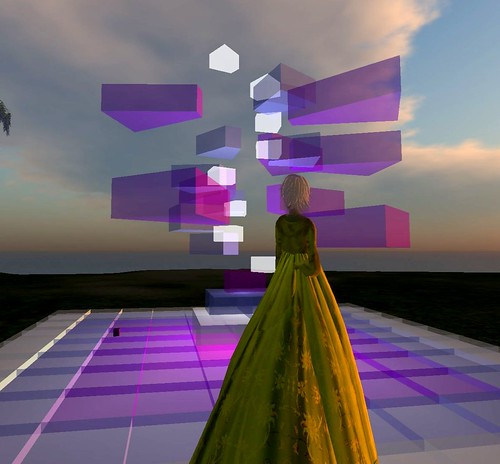
Touch each of the pieces and the floor of the installation to provoke movement and sounds
Adam had this to say about the piece, which was curated by Delia Lake, "The sounds in the work are based upon the inversion of the connotations of global justice: that of global terror. Much violence and mass murder has been perpetrated, ostensibly in the name of justice, and such acts continue to occur globally to this day. Therefore, I have sourced the sounds of gunshots (in particular the AK47, a symbol to some of the global terror movement), bomb explosions and screams, manipulating the harmonics according to a rational scale of my own devising, to create a compellingly beautiful yet haunting sonic system. Some philosophers, such as Peter Singer, extend the notion of global justice to all sentient beings - not only humans - therefore, I have also used the sounds of animals being slaughtered."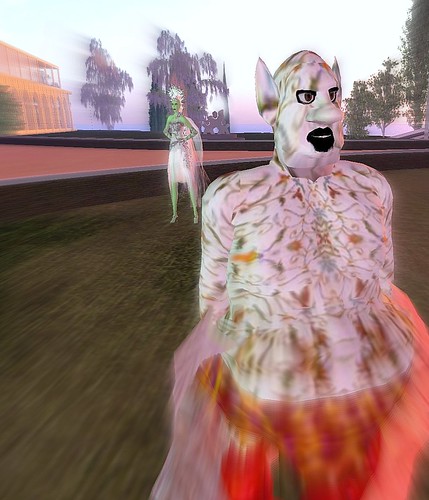
I profiled Adam Ramona and his "Unsung Songs" show in October
Adam went on to explain, "White is seen in some cultures to represent innocence and purity, a state from which global justice can be conceived. White is also seen as the colour of hospitals, and therefore perhaps represents one of the aims of the contemporary global justice movement, that of universal access to health care. Purple is regarded in some cultures as symbolising power and nobility, reflecting the aim of universal empowerment through global justice. Purple is also reportedly favoured by young children, returning the cycle to innocence and purity. I would like to acknowledge the assistance of Nicole Lawther in the conceptualization and design of this work."
Many thanks to the MacArthur Foundation, Global Kids and the Justice Commons for hosting this event, together with the USC Network Culture project. In addition to Adam Ramona, as well as Tooter Claxton and Pavig Lok who's installations I have recently blogged about, the following artists created original art works for this show: Tuna Oddfellow, AM Radio, Juria Yoshikawa, Dancoyote Antonelli, Filthy Fluno, elros Tuominen, Chance Abattoir, Josina Burgess, Velazquez Bonetto, Junivers Stockholm.
Posted by
Bettina Tizzy
at
2:30 PM
0
comments
![]()
Labels: Adam Nash, Adam Ramona, Basilica, Delia Lake, Global Kids, mac032008, MacArthur Foundation, Nicole Lawther, Not Possible IRL, NPIRL, Second Life, USC Network Culture, Visions of Global Justice
Zombie Robot!
I told you a few days ago about the :sick: sims (teleport directly from here), and how impressed I was with a pile of mostly undiscovered manga-style live-action videos shot there by mk Curtiz.
Yesterday, machinimator Masami Kuramoto, who frequents the Japanese sims and originally tipped me off to Curtiz's videos, alerted me to this new avatar - the Kurou Soldier also by mk Curtiz - that's loaded with options. Among its many tricks: it throws rocks, self-destructs, and emits laser beams from its head and hands. You can pick it up at :sick:, but you'd better be in a serious mood to be a zombie robot, as the purchase will set you back $1000L. 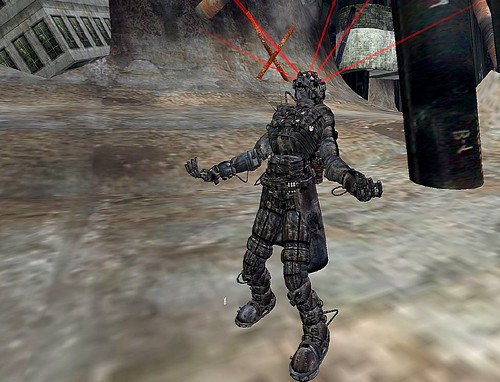
Posted by
Bettina Tizzy
at
10:55 AM
0
comments
![]()
Labels: avatar, Kurou Soldier, Masami Kuramoto, mk curtiz, Not Possible IRL, NPIRL, Second Life, sick, zombie robot
Designer Dingson's flight of fancy
Got a few minutes to spare and a yearning for beauty? The Architecture sim is a good place to start, as there is almost always a sweet surprise waiting to be discovered there.
Take this feather-light "concept build," (teleport directly from here) by Designer Dingson: rez: 11/17/2006 (aka Lester Clark), a British architect whose Real Life company, PRP, won the Architectural Practice of the Year building award in the UK.

Click to see large
It's also a good place to try out new Windlight presets. Oh, wait! It's not called Windlight anymore... now: RC2 for Release Candidate 2. 
Designer Dingson is probably best known in Second Life for recreating the Farnsworth House (teleport directly from here) by Ludwig Mies van der Rohe, a monumentally important architect and style-setter of the 20th century. 
In fact, Steve Rose, a columnist for the British newspaper, the Guardian, discussed the recreation in an interesting July, 2007 article that - bless him - embraces the NPIRL opportunities that virtual worlds make possible.
Posted by
Bettina Tizzy
at
10:00 AM
4
comments
![]()
Labels: architecture, Designer Dingson, Farnsworth House, Lester Clark, Ludwig Mies van der Rohe, Not Possible IRL, NPIRL, Second Life
Saturday, March 22, 2008
Dear Bleeding Edge Corporations (that goes for you, too, Mr. Anderson): Wired was unplugged in SL from day one, while Languagelab.com will endure
Remember the Money sim? Why this sim exists and what it will be used for will be disclosed later in this blogpiece, too.
Even on the day they were birthed, Wired Magazine's Headquarters in Second Life were so tired, they expired
Back in October of 2006, Wired magazine was trumpeting its arrival in Second Life with so ghastly an in-world presence (teleport directly from here), that the only possible conclusion I can reach is that it was a cruel hoax inflicted upon them by metaverse developer Millions of Us. The publication's uninspired virtual headquarters sport hideously unattractive offices with windowless cubicles (gasp!), and its grounds and stage are textured with circuit board green and made out to look like capacitators and a graphics card... 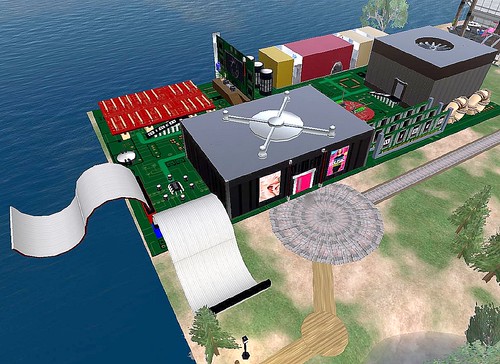
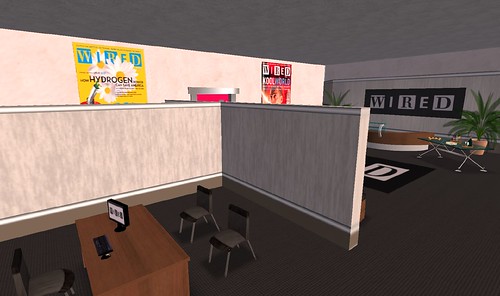
I dropped by this week to confirm its continued existence, and there it was. Even ghost towns get more visitors; its traffic: 33. To put things in context, my Second Life home at Chakryn Forest, which is open to the public (and offers no events, whatsoever), gets a daily average traffic of about 2500.
Wired's "travel guide to Second Life," was issued that same October 2006, and opens with this puerile text: "Taking a trip to the coolest destination on the Web? Our guide tells you where to go, what to do - and how to buy sex organs." Oh yeah. The real head-scratcher is that Wired was nominated for a National Magazine Award for this effort. I assume that this recognition had more to do with the publication's cheeky vision of the tadadada "future," rather than its grasp of the real potential that virtual worlds afford. Certainly history has confirmed as much.
And therein lies the problem that not only Wired magazine, but pretty much every single Real Life corporation that I know of (except Pocky!) has experienced to date as they fiddle around with their Titans-in-pixelated-cubicles (and we'll give you a free baseball cap and t-shirt, too!) approach. Not surprisingly, nine months after their launch in Second Life, Chris Anderson, Wired's editor-in-chief, and his minions were slamming the metaverse, and jumping ship. And like a house of cards, Real World corporations began to flee, one after another.
I'm not saying that Wired magazine isn't smart. I've been a subscriber for years. When you dare to walk beyond the known horizon, you are going to make mistakes, but Wired has often been incredibly right. They - and all the other bleeding edge corporations - were just incredibly wrong in their approach to Second Life.
Enter Edgware Marker and his Languagelab.com
I predict that a pioneering new brand with outsize ideas that's launching now just in Second Life will succeed where all others have failed. I think it will attract customers with exceptionally busy Real Lives who have never played WoW, and never been motivated to dip their toes in virtual worlds before. More often than not, these people will be smart, educated, have six figure salaries, and a vast network of friends and business associates. You don't have to work on Madison Avenue to recognize this demographic as the most desirable client of all.
Moreover, I forecast that Human Resource departments all over the world will soon be ponying up and sending their corporate executives in droves to Second Life to make use of this brand.
And that's not all. Out-of-work actors will quit their waiter/waitress "day jobs" in Hollywood and London and log in to Second Life... not just from 9-to-5, but around the clock... 24/7 (it's 5 o'clock somewhere, you know), and earn a real living.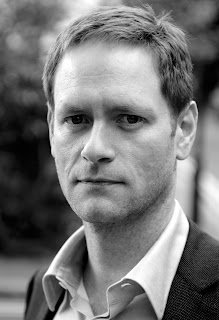 The man behind this enterprise is David Kaskel, a PhD candidate at the Center for Computing in the Humanities at King's College in London.
The man behind this enterprise is David Kaskel, a PhD candidate at the Center for Computing in the Humanities at King's College in London.
He's not new to Second Life, either. His avatar, Edgware Marker, rezzed 4/23/2004, has intentionally flown under the radar for the most part, though he is known to a few as a patron of the arts. Interestingly, I asked him last week if he had ever visited Wired's virtual offices. He had not.
His business: Languagelab.com, an immersive, virtual language school, peopled by first rate teachers from around the world, in addition to actors, who make the language come alive through first-hand experiences, coupled with an engaging curriculum.
Back in April, 2007, another publication geared to futurists, MIT's Technology Review, ran the article "A Boon to Second Life Language Schools - New technology will allow high quality audio in a virtual world," by Michael Erard, about David Kaskel's plans for an immersive language learning school in Second Life. The article points out that LanguageLab.com - already operating in Beta mode at the time - was the first language school built around Second Life's integrated voice capabilities. In fact, it even worked with Second Life's VoIP provider, Vivox, before Second Life had contracted Vivox to provide voice.
Today, Edgware Marker and his Languagelab.com own 18 sims, of which 15 are just now going public: Art, Home, Think, Arts, Living, Life, Office, English, Business, Conversation, Events, Jobs, Hotel, Nightlife and Play. This is an enormous investment by Second Life standards, but a modest one if compared against the cost of opening a Real Life language school in just one or two cities. Now consider that students can log in from all over the world... 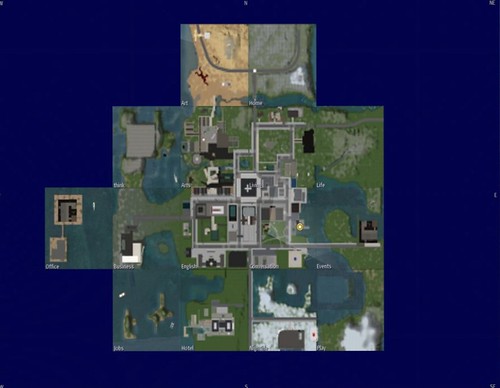
Taken together, 15 of those 18 sims comprise one big modern city, with all of the infrastructure, amenities and services a world traveler might expect to find, including a deluxe hotel, an airport, docks, several restaurants, bars, and cafes, shops, nightclubs...
...art galleries, museums, medical centers, beauty salons, parks, groceries stores, dry cleaners, a casino, a pharmacy, a real estate office, a church, a cemetery, a town hall, a post office, skyscrapers, a car rental company, many offices, a bed & breakfast, a movie theatre, and on and on... 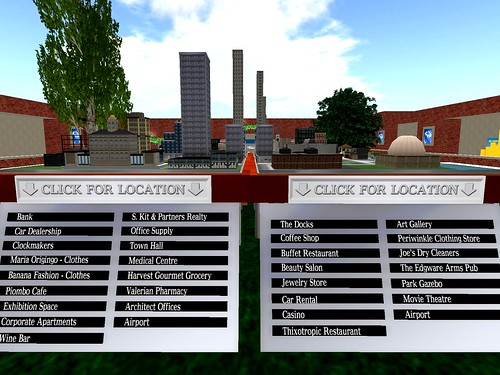
Landmarks can be taken for each location from a miniature model of the city that sits in the reception area of Languagelab.com
"Most of these facilities can already be found throughout the grid, so why not teleport the students here and there, and bring costs down to a bare minimum?" I asked Edgware Marker.
Edgware Marker: My theory is that language learning is accelerated when it is experiential and tied into the students' emotional and functional involvement. In a classroom, there might be an intellectual reason to learn, but in our city, where I have hired actors to play functional roles at specific locations and bring the city alive, we have shifted the emphasis and the student is engaged emotionally and learns differently, much more quickly.
Bettina Tizzy: What will the actors be doing? You will walk into a cafe, and order a coffee?
Edgware Marker: The biggest problem that people have in Second Life is that they see a cafe, and it is empty. In our city, you will ask, "who is in that cafe, and what are they doing?" Our trained actors are fully integrated into the Languagelab social environment. Moreover, the environment (social & physical), has been designed with its own evolution in mind. As the students and actors interact, so too, their roles and functions have been scripted to change not just over the course of an encounter but the days, weeks and months ahead. We have done a lot of research on the effect of the emotional environment on learning. This will be done both through explicit and implicit components of their individual environments. We’ve been looking beyond our 3D (spatial) creativity and building competence. We’re looking to apply the same creativity to some of the temporal aspects of the build (apologies for being a little cryptic on that one).
Edgware Marker: What I can tell you is that our actors will have roles that are rich with narrative and story arcs. Our students will come to know them and their personality traits in much the same way they would in Real Life. We are applying that character identification that you find when you see a film, or read a book or even by watching soap operas. We have already seen that this is a better way to learn a language than in a physical classroom. 
Edgware Marker: At Languagelab, our students are doing it rather than talking about it
Bettina Tizzy: Where are the actors coming from?
Edgware Marker: Our first set of actors are professionals who were already residents in Second Life. We're now going to specific acting communities to hire disabled actors, and bring them into Second Life.
Bettina Tizzy: Back in December, you gave NPIRLers a preview of a mysterious and eerie sim called Money, that had been built by Light Waves, Pavig Lok and LittleToe Bartlett. Will that be a Languagelab.com sim, and if so, how will it be used? It is hardly your everyday type of location. 


Photographs of Money by Arahan Claveau
Edgware Marker: This is a more experimental idea. While it won't open for a while, our plans are to use it as a location for a fast-paced language-learning scenario, where our students will get an accelerated adrenalin rush.
Bettina Tizzy: Only your students will have access to this sim?
Edgware Marker: I'll let you know more about that later.
Bettina Tizzy: What was the evolution of your own understanding that virtual worlds could be used for language learning?
Edgware Marker: I can think of three key moments in this interesting journey. The first was many years ago while playing DAoC regularly with a German guy. I was struck by just how quickly his English fluency improved solely through social interactions in a virtual environment. In one month (of intense play) he went from beginner level to nearly fluent, albeit in an MMO/text based context. Sometime later, I was making rather slow progress with my Italian, even though I was attending one of the leading language schools; but then an hour in a Naples taxi underscored, for me, the real power of a fully immersive environment. It didn’t take much thought to bring those two experiences together. Finally, it has been the result of my own doctoral research on the relationship of people with their (and others’) avatars.
Bettina Tizzy: Your approach to using the virtual platform strikes me as being several steps ahead of everyone else. Are you holding back from even more radical ideas, and would you care to give us a hint as to what those ideas might be?
Edgware Marker: If we are ahead, then it’s the result of nearly three years of highly structured research and experimentation with specific goals in mind. We’re launching now and are well advanced in the development of our gen-2 and even some gen-3 ideas.
Bettina Tizzy: Are their advantages to corporations in establishing a presence now?
Edgware Marker: It’s a question of opportunity and efficiency. Just as the games industry has comprehensively eclipsed the film industry in value (both in terms of money and time spent), so virtual environments will surpass (without replacing) many existing social/commercial interaction media. Being ahead of the curve is simple pragmatism; it takes significant time and resources to gain enough experience to deliver strong enough products and services.
Bettina Tizzy: Other than the classic techie, what other audiences do you think will be the earliest adopters to take up and assimilate in virtual worlds, and therefore your classes?
Edgware Marker: We are finding that adoption is based on the new opportunity it presents. Many of our earliest students were not even in Second Life beforehand, and certainly not your average early-adopter tech-head. They’re attracted by our ability to meet specific needs: Content needs: delivering what they need but can’t get from anywhere else (e.g. native speaker practice in many parts of the world). Access needs: giving them the services and facilities they want when they need them and wherever they are based. Financial needs: providing education at a fraction of the costs of exisiting Real Life alternatives.
Bettina Tizzy: What languages will you be teaching initially and where do you expect to get most of your students?
Edgware Marker: We're going to focus on English at first, and expect that most of our students will be from China or Spain.
Bettina Tizzy: The Languagelab museum has an important collection of Starax's art works. I saw several other artists represented. It's clear that you have already established solid ties with many of the best content creators in Second Life. How long do you think they will have to wait before their services are in high demand and claiming top dollars?
Edgware Marker: Well, for some it has already happened. A small minority are already claiming top dollar. The question should really be how many of the best can claim these rewards. That is a function of the products and services they are supporting generating significant incremental value to their clients. As businesses start to succeed as businesses in Second Life, so the value of strong, creative and reliable support services becomes self evident. It shouldn’t be forgotten though, that Second Life is very much a global marketplace for services. American and European designers, for example, must compete with Chinese, Brazilian or South Africans of tremendous talent and enterprise.
Posted by
Bettina Tizzy
at
11:39 PM
2
comments
![]()
Labels: acting, business, Chris Anderson, corporations, David Kaskel, distance learning, Edgware Marker, English, immersive, Languagelab.com, languages, role playing, Second Life, virtual worlds, Wired
Gary Hazlitt's latest Machinima/music vid: "Hide and Seek"
I spoke briefly yesterday with that Sydney-based Brit and marketing wiz, musician, composer and rich content creator in virtual worlds Gary Hazlitt (aka Gary Hayes), when he happened to mention - among other things - that he had a few days off and that he "might make a little Machinima."
Gary, who studied physics - I border on worshipfulness when it comes to physicists - is the director of the Australian Laboratory for Advanced Media Production (LAMP), and also heads up Virtual Worlds for the UK-based The Project Factory, for which he produced the highly successful and eminently revistable (as the traffic numbers indicate) Australian Telstra and ABC Second Life presences.
I've just now learned that Gary had a productive Easter weekend Saturday and paid this NPIRL compliment to three of our fave builds in the metaverse, from start to finish, including the avitanimation and editing, in just five hours:
Credits:
This JustVirtual production features the song "Hide and Seek" by Imogen Heap from the album Speak for Yourself.
Gary shot the video at Lumiere Noir's fantastic tribute to Flash Gordon: Planet Mongo, at our beloved Svarga by Svarog Laukosargas, as well as a new sim that Gary has just finished creating but is still not open to the public: Deakin.
Lip sync animation created using Crazy Talk 5, green screened in Final Cut. The spaceship shots were filmed live in Second Life.
Posted by
Bettina Tizzy
at
7:56 PM
0
comments
![]()
Labels: avitanimation, Deakin, Gary Hayes, Gary Hazlitt, Hide and Seek, Imogen Heap, Lumiere Noir, machinima, Not Possible IRL, NPIRL, Planet Mongo, Second Life, Svarga, Svarog Laukosargas
Tooter Claxton sounds off on justice with his "Free world - the fenced edition"
Tooter Claxton is no stranger to these pages. This Dutch, punk-rocking, avatar-making, Second Life Hobo is an articulate and informed, somewhat mad/ingenious graphic designer and art director in Real Life, and a favorite personality of mine.
In my dealings with him, I have come to recognize another quality in Tooter that I so admire: integrity. Tooter shoots straight and he's true to himself. And he's funny while he's doing it. Can't say that about too many people. 
I didn't thoughtfully consider this unique combination of attributes before I invited him to participate in the "Visions of Global Justice" group art exhibition in Second Life. I just knew it in a flash. Ah, what a good kind of flash that turned out to be! The even better news is that he accepted, and his installation joined those of over a dozen artists who came together for the opening of the International Justice Center.
Tooter's piece is called "Free world - the fenced edition." Walk up to it (teleport directly from here), wait a few seconds... and you are in for a surprise. 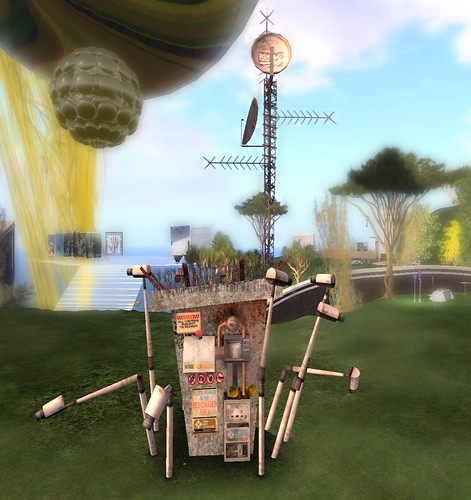
Tooter explains it this way:
Tooter Claxton: Justice and law are based on agreements between people of what is right and what is wrong. Sometimes the difference between right and wrong is evident to everyone, but it isn't always that clear (that's why we need to write the agreements down in books of law, treaties and such) and the line between them can get fuzzy or even disappear. The two sides can even flip, depending on the perspective or interpretation of the viewer. When is someone a freedom fighter? A patriot? A terrorist or an enemy of the state? 
A small, high walled structure, fenced off thoroughly with barbed wire and thick walls. Inside is some grass and flowers on the ground and a door with a lock and a key. The outside walls are textured with 'jail graffiti' and surrounded by a forest of cctv camera's moving around like meerkats, eyeing the visitor.
There are scanners, lights, lots of beeping and humming and scripted checks of the visitor. Security is over the top. Way over the top. Even their trash is sifted through.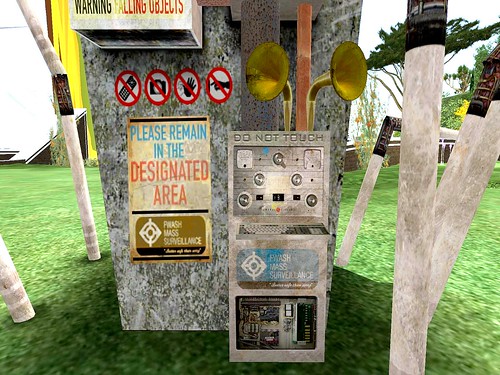
Tooter Claxton: In other words: we punish criminals by putting them in confined spaces, so we can watch and control everything they do. The criminals obviously experience this control and lack of freedom and privacy as punishment. But we, who have committed no crimes, have not been convicted of anything, are increasingly being watched and controlled in the same way: our emails and Internet history can be stored and read, our phone calls are being scanned by the NSA a.s., we get bio-metric passports, all your trips and purchases can be traced through air miles and credit cards, and the cities are full of cctv's watching our every move... Is there still a free world? Are we still innocent until proven guilty? 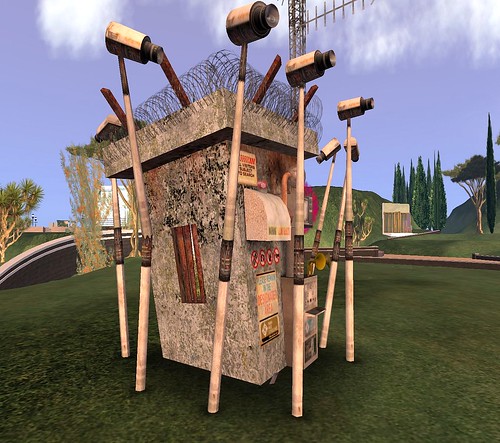
WARNING: SPOILER! READ NO FURTHER IF YOU THINK YOU'D LIKE TO EXPERIENCE THIS PIECE - BUT GO NOW... EXHIBIT WILL END IN ONE DAY! Impressively scripted by Paladin Pinion, text by Tooter Claxton
I walked up to the structure, and a few seconds later, it started talking to me:
[22:26] ::: Initializing. Please remain stationary, Bettina Tizzy
[22:26] ::: Please stand in the designated area. You have received your location 2008-03-20. Check your inventory Bettina Tizzy.
[22:26] ::: Free World Access Scanner Hub (FWASH) activated, please wait.
[22:27] ::: ::: :::
[22:27] ::: We are strongly committed to your right to privacy, Bettina Tizzy. Please read the privacy disclaimer provided by FWASH, available to all Free Citizens.
[22:27] ::: FWASH error: unable to deliver privacy disclaimer. Free World group membership detection not available at this time.
[22:27] ::: Please enable scan and temporary deactivation of Data Protection Act by typing 'I agree' in chat within the set time.
[22:27] ::: Please note that except as otherwise expressly provided, whenever in this Act an amendment or repeal is expressed
[22:27] ::: in terms of a section or other provision of the Data Protection Act of 1984 (47 U.S.C. 151 et seq.), Section 3 (47 U.S.C. 153) is amended: in section 332(d), by striking `section 3(n)' each place it appears and inserting `section 3'.
[22:27] ::: ::: :::
[22:27] ::: ::: :::
[22:27] ::: No response from agent Bettina Tizzy detected within set time. Scanner status: suspicion of possible concealment of identity by agent. Agent status set to 4-B: suspect. Initializing full scan. Please wait.
[22:27] ::: ::: :::
[22:27] ::: FWASH identity confirmed: Bettina Tizzy. Retrieving data. Please wait.
[22:27] ::: ::: :::
[22:27] ::: Your Universally Unique Identifier: cb84ba5a-70bb-4ba7-85c7-a29992d42382 Status unverified.
[22:28] ::: UUID Confirmed suspicion rate 4.7. Restrictive violence acceptable. Subsequent action classified to agent.
[22:28] ::: Facial recognition unit initializing... FRU ready.
[22:28] ::: User Bettina Tizzy born: 2007-01-26. No history of active membership of Free World group detected.
[22:28] ::: Possible membership of non governmental organizations detected.
[22:28] ::: Your Payment info on file: Status: 3-PAYMENT INFO ON FILE Scanning for other payment methods and potential fraudulent transactions.
[22:28] ::: Repetitive purchase of foreign comestibles tracked on loyalty cards: Pizza.
[22:28] ::: Repetitive purchase of foreign comestibles tracked on credit cards: Pizza.
[22:28] ::: Domestic comestibles purchase rate: 5 – average. Probable polynationalism or lack of patriotism detected. Xenoscan Tracking permanently enabled on Bettina Tizzy.
[22:28] ::: FRU scan result: Undetermined moisture detected, probability cold sweat: 87.472%, probability wallpaper adhesive: 12.528%.
[22:28] ::: Retrieving your energy invoices and air miles statistics to determine Fuel Consumption Level for Bettina Tizzy with mass 1.822263. Ratio of mass to energy utilization is not within projected economic stability range.
[22:29] ::: FWASH FCL 3.2 Category Treehugger
[22:29] ::: Avatar clothing changes: over 256 since 2007-01-26. Possible ID concealment. Avatar clothing changes: less than 512 since 2007-01-26. Possible use of alternative accounts.
[22:29] ::: Liquidity in Linden Dollars per day: < 565. You are extremely poor. Enabling financial tranquilizer for Bettina Tizzy.
[22:29] ::: ::: ::: ::: :::
[22:29] ::: Financial Tranquilizer: -start message- Welcome Bettina Tizzy. Money isn't everything. Keep in mind that over 3.8 billion people have less than 565 Linden dollars a day to spend. In the real world. Count your blessings.
[22:29] ::: Financial tranquilizer: Poverty is a choice, Bettina Tizzy. Obey and prosper. -end message-
[22:29] ::: Financial Tranquilizer is offline.
[22:29] ::: ::: :::
[22:29] ::: ::: :::
[22:29] ::: Engaging Waste Analyzer
[22:29] ::: ::: :::
[22:30] ::: Waste Analyzer engaged. Connecting to Department of Sanitation.
[22:30] ::: ::: :::
[22:30] ::: Connected. Scanning garbage bag 00567 through 02441 - Bettina Tizzy. Please wait.
[22:30] ::: Thank you for your patience.
[22:30] ::: ::: :::
[22:30] ::: Traces of addictive substances found. Coffee. Possible tofu. Notifying Drug Abuse Prevention Task Force.
[22:30] ::: Scan finished. Please wait for results.
[22:30] ::: ::: ::: ::: ::: ::: :::
[22:30] ::: No criminal record for user Bettina Tizzy. Suspicion level 7. Estimated loyalty rating index at 2.1
[22:30] ::: Preemptive safety measures will be taken. Please wait.
[22:31] ::: Bettina Tizzy taken into custody by FWASH on suspicion of planning potentially subversive acts.
[22:31] ::: Bettina Tizzy will remain detained.
[22:31] ::: Entrance to Free World denied.
[22:31] ::: Thank you for you for keeping the Free World safe, Bettina Tizzy. Have a nice day.
~*~
This just in and direct from Tooter when I asked him for the authorized bio:
"I don't get bored easily. I am a graphic designer/ art director by profession but I have done, and still do a lot more. I have been singing and/or playing guitar in bands since 1976; punk rock, bluegrass, country, traditional dutch music, german schlagers and even just plain old rock 'n' roll. I've also hosted a variety of shows, quizzes and contests. I design and illustrate books, magazines, and occasionally write for them too. I draw comics and make animations. I've made hundreds of posters, flyers and record sleeves for the local and international 'underground' music scene. I've spent many holidays making and playing theater shows, I have worked with poets, sculptors and painters, making installations in musea, illustrations, short films, prints, performances. And then there's computers...
I've been working with computers since shortly after I left art school in the early eighties. First I tried programming in Basic, making simple games, but I soon used them to design typefaces and animations. After that computers have become an integral part of my work and life.
For the past year and a half I have also been active in Second Life. I spend most of my time in sandboxes, playing and building. I particularly enjoy the absurd side of Second Life, and I see it as an eclectic artwork made by all it's inhabitants. I learned (and still learn) building from other more skilled builders (mostly from the hobo group) and try to add pieces to the dadaist collage that is already there. I 'make a living' in Second Life selling somewhat 'off' avatars, which makes me enough to pay for rent, tier and a premium account. The more I make, the more land I buy to build my own projects on: usually silly, more than often useless. I try to make as many freebies as I can, and as I am selling more and more avatars, I've been giving away more of my builds free. I've also done -and cooperated in- artworks in SL. Most were themed around (dis-) communication, one of the most interesting parts of Second -and real- Life i.m.o."
Many thanks to the MacArthur Foundation, Global Kids and the Justice Commons for hosting this event, together with the USC Network Culture project. Special thanks, too, to In Kenzo, for giving me the opportunity to serve under her as co-curator, thereby allowing me to learn much about how to curate an art event in virtual worlds. In addition to Tooter Claxton and Pavig Lok, whom I featured in my last blog post, the following artists created original art works for this show: Tuna Oddfellow, AM Radio, Tooter Claxton, Juria Yoshikawa, Dancoyote Antonelli, Filthy Fluno, elros Tuominen, Chance Abattoir, Adam Ramona, Josina Burgess, Velazquez Bonetto, Junivers Stockholm.
Posted by
Bettina Tizzy
at
10:57 AM
1 comments
![]()
Labels: art, freedom, Global Kids, International Justice Center, justice, mac032008, MacArthur Foundation, NPIRL, Second Life, security, surveillance, Tooter Claxton, USC, Visions of Global Justice
Friday, March 21, 2008
Pavig Lok's "Intellectual Property Garden"
Despite the smallish size of Pavig Lok's avatar, this well-honed and witty character packs a powerful punch: great intelligence, a breadth of knowledge that spans many fields, and uncompromising sincerity. 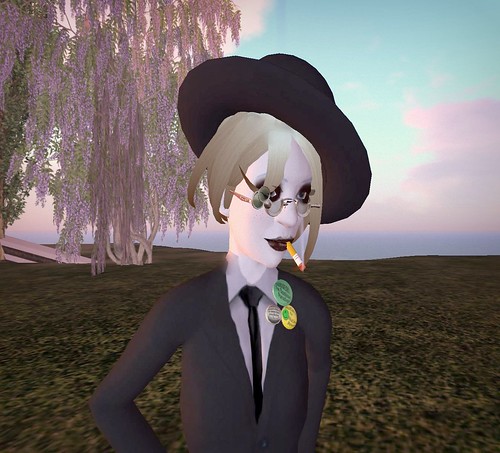
It was my recent pleasure to co-curate, together with In Kenzo (aka Evonne Heyning), and Delia Lake, a group art exhibition in Second Life featuring the works of over a dozen artists. The occasion was the opening of the International Justice Center, a “virtual clearinghouse for information and action in support of global justice and the International Criminal Court,” and the theme: Visions of Global Justice. While Pavig is best known as the lead-creator of Greenies Home Rezzable, and for being an active participant in the Second Life Hobo community, there is another side to this person that I admire, so given the opportunity to invite four artists, I was very pleased when Pavig agreed to participate.
Tasked with conceiving and creating an original and themed art installation with less than 100 prims, Pavig weighed in with a concept and an 18 prim 3D sculpture that shatters the notion that virtual worlds are useful solely as mindless sources of entertainment: the "Intellectual Property Garden," (teleport directly from here). 
Pavig describes the piece as follows:
"A child is seen in a field blowing a dandelion. The flower and seeds are composed of copyright symbols, which can also be seen growing wild in the field. To the child the dandelion represents making a wish. To the adult it is a garden pest which stifles the growth of preferred plants. Every adult knows this when they teach a child to blow dandelion seeds, yet they encourage the child to spread the pest throughout their garden. Is this responsible stewardship?"
Now, I have always found Pavig to be deliberately succinct and someone who generally uses the fewest number of words possible to convey a message, so imagine my amazement when the notecard that accompanies this piece goes on to say the following:
What has intellectual property got to do with justice?
The practical application of justice is law. Law, we know, primarily concerns itself with property and ownership. Crime and punishment is a much simpler domain than that of property, where establishment of rights is by definition far more abstract – less universal. Property exists nowhere in the world, only in contract, agreement, or the award of possession through lawful interpretation of a chain of events.(1)
History, however, provides endless examples of the application of law in ways which may offend our natural sense of justice. One need only look to the distribution of ownership by kingdoms, states, politics and corporations in one's lifetime for many examples.
With ideas now increasingly falling under the umbrella of property law, the abstract idea of ownership becomes increasingly ephemeral. Whilst initially conceived as a protection for the individual, copyright is now increasingly owned by corporation – the modern kingdom. Those who wish to trade with us must agree to be annexed into this kingdom – to practice our conception of justice and ownership over ideas. They become subject to our proprietary rights.
There is some protection in justice as applied by law, but can we be sure natural justice is served. Copyright, patent law, access to technologies, educational materials, information in general; the bread and butter of intellectual property is not distributed evenly.(2)
Just as property law divides the map of our land into rectangles representing right of passage or tresspass, intellectual property segments our intellectual environment into no-go zones based on the provenance of thoughts and ideas. Our children grow and are educated in this environment; our business and nation building, and thus the day to day struggles of our people, are practiced within it.
When corporations in far countries can own; the tools and stories we use to educate our children(3), our own genome and thus our ancestry and makeup(4), the genome of the diseases that kill us and the formula for their cures(5), the living structure of the plants we sow and breeds of the animals we harvest(6), the design of the tools of our industry and anything which we invent ourselves which resembles or replaces them(7); then can we be sure natural justice is being served.
_________________________
Footnotes:
1 We know that property law deals with abstracts in that it's primary unit of exchange, money, is itself ephemeral. The value of these tokens is simply one of agreed consensus within the market – a consensus which shifts to and fro on a daily basis, and thus is removed from any intrinsic value that the Dollar, Euro or Yen may represent. This has arguably been the case since the abolition of the gold standard.
2 Access to a system of law does not imply a balanced justice system. Intellectual Property law, such as copyright and patent law, requires a large and highly developed infrastructure to establish provenance. When new players enter an IP regulated market – such as is the case through recent “free trade” agreements, where right to trade is contingent on adoption, adherence and acknowlegement of existing intellectual properties and systems of law – we should expect the new entrant to start at a severe disadvantage. A smaller nation trading with the USA is a fine example. In the United States almost anything patentable has been patented. This includes, for example, a button on a website that says “buy” - something which should seem obvious and un-patentable as a pre-requisite for patent is novelty. It is unreasonable to expect a smaller nation to compete with the established body of patent claims which exists on such a granular level in developed nations. For the significant social costs of implementing a patent system on developing nations see: Samuel Oddi, The International Patent System and Third World Development: Reality or Myth?, 1987 Duke Law Journal 831 (1987).
3 Educational use of existing materials covered by copyright comes under either a licensing or fair use provision in law. As the rights under copyright are extended, fair use provisions come under pressure. Now the mere threat of litigation presents an economic burden on educational institutions, who must now practice citation and study of copyrighted works defensively. These increased costs alone, and the restrictions on use of works for education to avoid them, are changing the practice of education even in affluent nations. In jurisdictions where the development of IP law has outpaced complimentary fair use provisions, this burden is correspondingly increased.
4 Since sequencing of the human genome, various parts of it have been subject to ownership under intellectual property law. Particularly famous cases of this pertain to genetic sequencing of indigenous populations, who may have a body of native law concerning ancestry, and thus their genetic heritage. Unwittingly transferring property rights to the unique sequence of their DNA brings native law and intellectual property law into conflict. Can a corporation own what makes one ones-self without informed consent? How are the benefits of ownership of this property distributed? Distribution of advantage can be worth considerable sums in cases where natural immunity to diseases within a genome confer towards a commercial treatment for disease – a situation where western property law is often poorly structured to remunerate donor groups. For further research on ethical and other concerns, the “human genome diversity project,” and “the genographic project,” and controversies surrounding them, are a good starting point.
5 Contention may arise in the patenting of gene sequences of disease. The first company to genetically sequence the SARS virus now owns it – though our natural sense of ownership would say it is owned perhaps by nature or humanity, if the concept of ownership is even an appropriate. This right of ownership under intellectual property law however, allows the company to contest a right to part ownership or interest in any cure which may be developed. It is not hard to see how such a system could be abused. Biological patents are nothing new, and neither is controversy regarding their use as a barrier to legitimate research. Compliance with a system of biological patent precludes nations with weaker economies from engaging in research on equal terms by eating up research budgets in order to comply with legal licensing against a stronger unit of currency. With over half a million gene patents filed in the last few years, biological patenting has entered a new era, and controversy will continue as law continues to adapt to this new area of intellectual property.
6 For evidence where IP affects crops, one need look no further than the “terminator seeds” controversy. In order to protect the biological intellectual property of it's own nation, the US Department of Agriculture developed a genetic method to turn second generation seeds sterile – a so called GURT or Genetic Use Restriction Technology. Of course, the outcome, should this technology hit the market, is that smaller nations, indigenous and rural farmers, would become dependent on the agricultural industry for seed on a seasonal basis. This undermines the 12,000 year old practice of saving the best seed from each crop for sowing the following season. Similar issues can be found in biological patent and “usage rights” on animals for breeding purposes. Overlap between patent rights to plant materials and long established law such as plant breeders' rights is another source of contention.
7 The use of patent law to stifle technological development is well documented. Arguments of this sort cite a “negative right” the patent holder gains, allowing them to exclude competitors from exploiting a similar invention they may develop independently. The legal burden of producing prior art in such cases can preclude the competition from proving their case even when they may have developed the invention first. When this is the case and a patent is contested, the competitor may be forced to cease development of the invention, or pay a licensing fee for use of the others' IP.
_________________________
During an "artist talk," at the gala opening of the show, Pavig went on to explain:
"I came here tonight ready to engage in a complex diatribe about art – about art being too complex to be specific. The irony was not lost on my closest friends, who put me right. For that I am truly thankful.
My rant was full of the exact hubris I was arguing against. That we, as artists, “hide our statements within a cryptic mishmash of semiotics.” So I set out to hoist myself with my own petard, by overcomplicating discourse on overcomplicated art about a complicated subject; justice.
I realized that everything I wanted to say about art had been said before, much more eloquently and concisely, by Charles Bukowski. It's a quote I've written at the front of all my journals to remind myself not to talk around things but to them – hoping to become more of a poet really, than a rather well read intellectual boor.
He said;" An intellectual is someone who says a simple thing in a difficult way. An artist is someone who says a difficult thing in a simple way." This is precisely the message I hoped to impart.
The theme of justice can be discussed endlessly – it is complex, multifaceted, confusing, just too darn hard to address. As a friend said to me: “the world's biggest economic / political problems are not hidden from the public in any way, there just to complex for the public to comprehend.” Yet we all have a sense of justice which we are sure we know intimately – this is natural justice.
We all know natural justice from our basic moral stance. This is something bodies such as the United Nations seek to codify, in their statements of basic human rights. We should not allow folk to be subject to violence. We should not allow folk to starve so that others can become obscenely rich. We should not displace folk from their land. We should implement systems to minimize the possiblility that these offenses to basic human dignity happen.
The principles of justice are simple – it is in the implementation of justice, our laws, systems and so on, that they become complex. Law is the formalization of justice – the justice system – and in being so complex it is sure to have it's faults and loopholes.
My piece is about Intellectual Property as it relates to justice. Though I deliberately haven't talked about this before – I'm, sure you all know, I.P. Law is a subject of concern to those in virtual worlds. My piece implies that I.P. Law is part of our environment. For folk who spend their time on the web and in SL all property is virual, intellectual property. Our sense of basic justice often touches on intellectual property issues due to this. I'm not here to preach to the converted.
Intellectual property however is part of all of our environments, and impacts real world concerns as well. As the notecard in my piece illustrates, it is of profound significance to issues we may not expect. It has implications for justice which are complex, multifaceted, not at all cut and dry. It has justice implications outside what we may percieve as it's narrow domain. It is a complicated matter.
So I tried to make my piece say some very simple things about the concept of intellectual property:
It is part of our envirnoment, like a weed or a flower.
IP and justice are related. It is in the justice commons – the subject is relevant to the context.
Our view of intellectual property is naive and obscured, and personal. It is a childs view. We see the shadow of it (a flat view like the shadows on the walls of Plato's cave) but not the whole. Every viewer sees it slightly differently (as the exact shape is dependant on viewing angle).
IP may have a dark side – though it's an idylic scene, it's black after all. (More detail on this aspect is revealed in a notecard in the work onclick.)
And Intellectual property is like the dandelion. Kid's may call them “fairies” but gardeners call them weeds. If we spread it throughout our environment without concern for the implications, eventually we'll have to weed it out where it becomes a pest.
Hopefuly my piece acts as an invitation for people to discuss the complex issues surrounding intellectual property. As law it is one of the tools of our formal justice system. We must watch IP law closely as it develops to ensure justice is the outcome."
Many thanks to the MacArthur Foundation, Global Kids and the Justice Commons for hosting this event, together with the USC Network Culture project. Special thanks, too, to In Kenzo, for giving me the opportunity to serve under her as co-curator, thereby allowing me to learn much about how to curate an art event in virtual worlds. In addition to Pavig Lok, the following artists created original art works for this show: Tuna Oddfellow, AM Radio, Tooter Claxton, Juria Yoshikawa, Dancoyote Antonelli, Filthy Fluno, elros Tuominen, Chance Abattoir, Adam Ramona, Josina Burgess, Velazquez Bonetto, Junivers Stockholm.
Posted by
Bettina Tizzy
at
3:20 PM
1 comments
![]()
Labels: art, Global Kids, Intellectual Property Garden, International Justice Center, IP, justice, law, MacArthur Foundation, Pavig Lok, Second Life, USC, USC Network Culture, Visions of Global Justice
Sunday, March 16, 2008
Striking ways to present flat art in virtual worlds
DB Bailey has designed an installation for an exhibit of photographs by Paul L. Gabbert that portray dancers of various tribes from Papua, New Guinea at the 50th anniversary of the annual Goroka cultural show, where participants dance and sing.
While I generally cannot be bothered with images of Real Life art within Second Life, DB Bailey has created such a lush and compelling oasis for these photographs, that I took the time to study the faces of the dancers and learn more about the event... and was reminded that tribal beauty in our world is ancient and fragile, and its preservation is more important than ever.

The frames in this area simply wouldn't be possible in Real Life... 
Adjacent to the entrance of the photography exhibit is one of DB's newest sculptures... (teleport directly from here). 
Posted by
Bettina Tizzy
at
12:48 PM
0
comments
![]()
Labels: DB Bailey, flat art, Goroka, installation, Not Possible IRL, NPIRL, Papua, Paul L. Gabbert, photography, sculpture, Second Life
Early reveal of Seadryke: Kazuhiro Aridian's newest avatar
There are hundreds of avatar creators in Second Life, but the mark for the highest quality and detail sans pareil belongs to one person. The last time Kazuhiro Aridian introduced one of these mythological beings, there was a spectacular wave of appreciation. The buzz in the sandbox as Kaz worked... why I've never seen anything like it, before or since.
Now Kaz is finalizing a docile, unguarded and ever so delicate creature... like a sea leaf, or feather, and its name is Seadryke.
Having worked in Maya for the sculpties (71 prims at this point), Kaz is going on to create 30 animations, using Qavimator.
Kazuhiro Aridian: I've made five animations, but I'm only happy with two so far. What's left? The AO, the HUD, and the special animations will be based on about 20-30 particle emitters and an animation that puts him 10 meters underground. 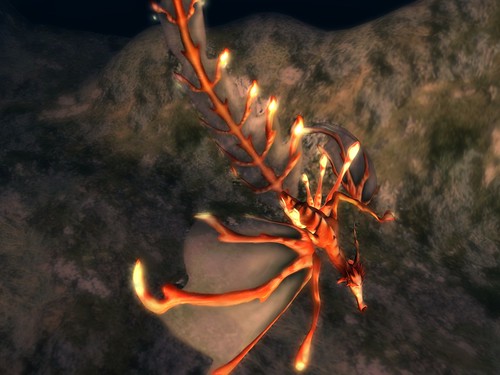
Kazuhiro Aridian: You will push the button, and all the boxes will send out a short burst of "ink," so there's a lot of emitters, and they'll make the shape of the avatar before he hides... kinda like a nightcrawler sort of effect, I guess! He's also going to shoot bubbles and ink out of his mouth, and other animations like that.
Kazuhiro Aridian: I'm further developing the story behind my shoppe. Kaz is a dream explorer. She/he resides within the realm of the Dreaming, and collects these dream beasts. The shoppe is a trading post of dream creatures.
Bettina Tizzy: How do you mean? "dream explorer?"
Kazuhiro Aridian: She wears steampunky sorts of clothes, and has wings made of cogs and clouds.
Posted by
Bettina Tizzy
at
11:05 AM
0
comments
![]()
Labels: avatar, Kazuhiro Aridian, Not Possible IRL, NPIRL, particle emitters, sculpties, sea creature, Seadryke, Second Life



